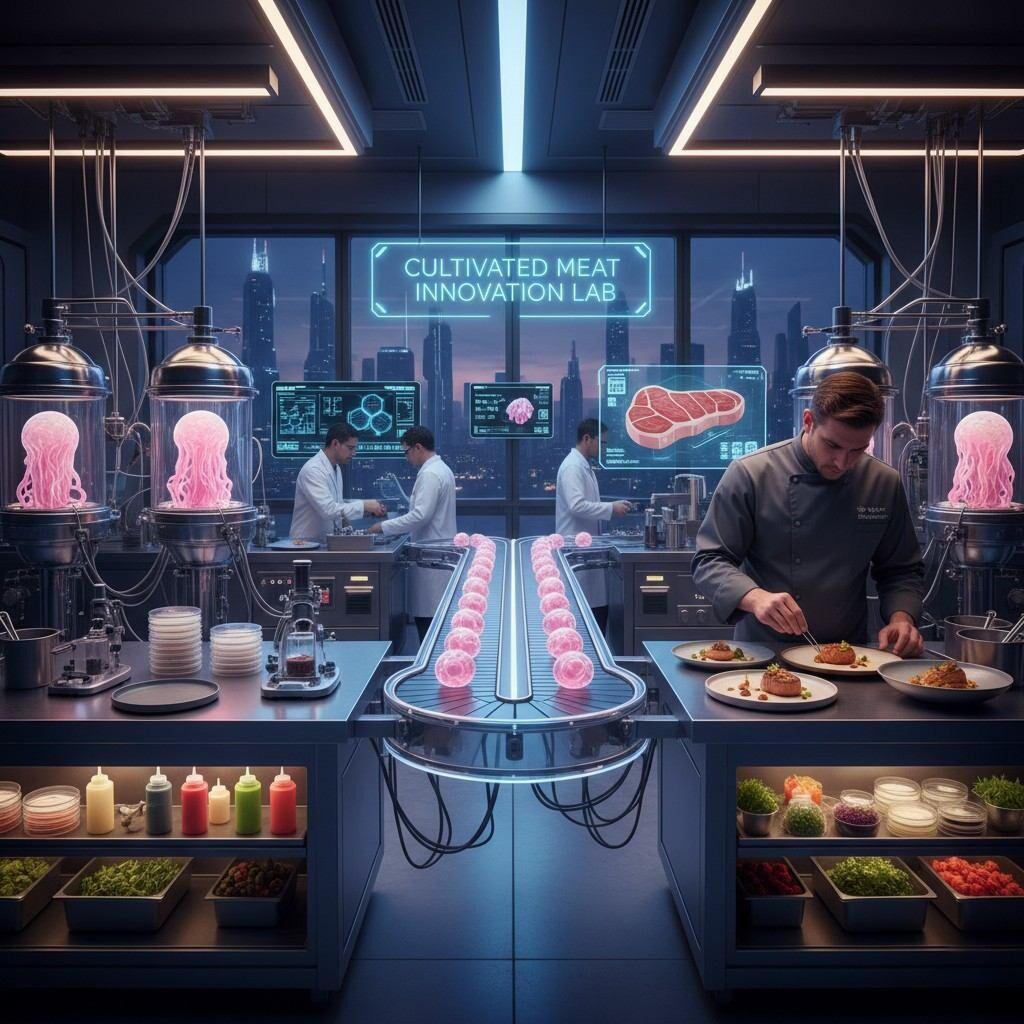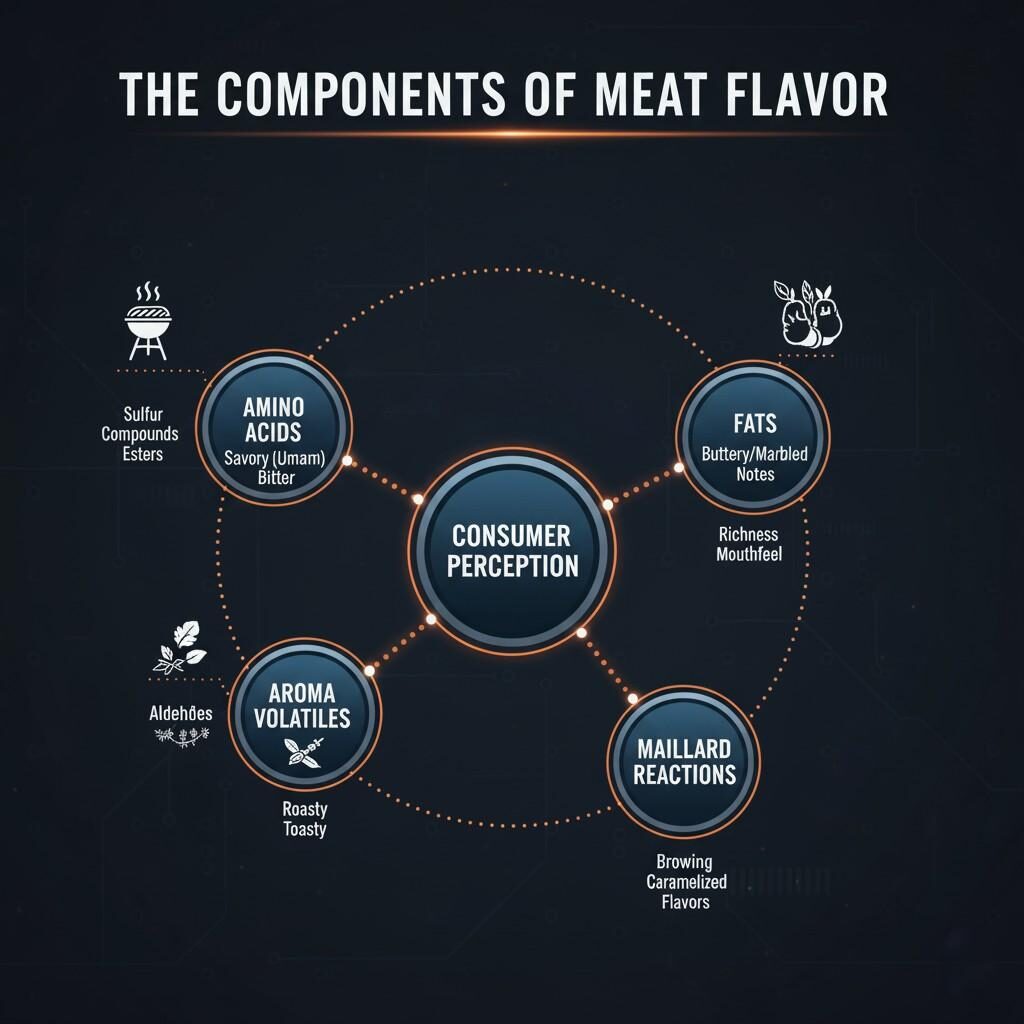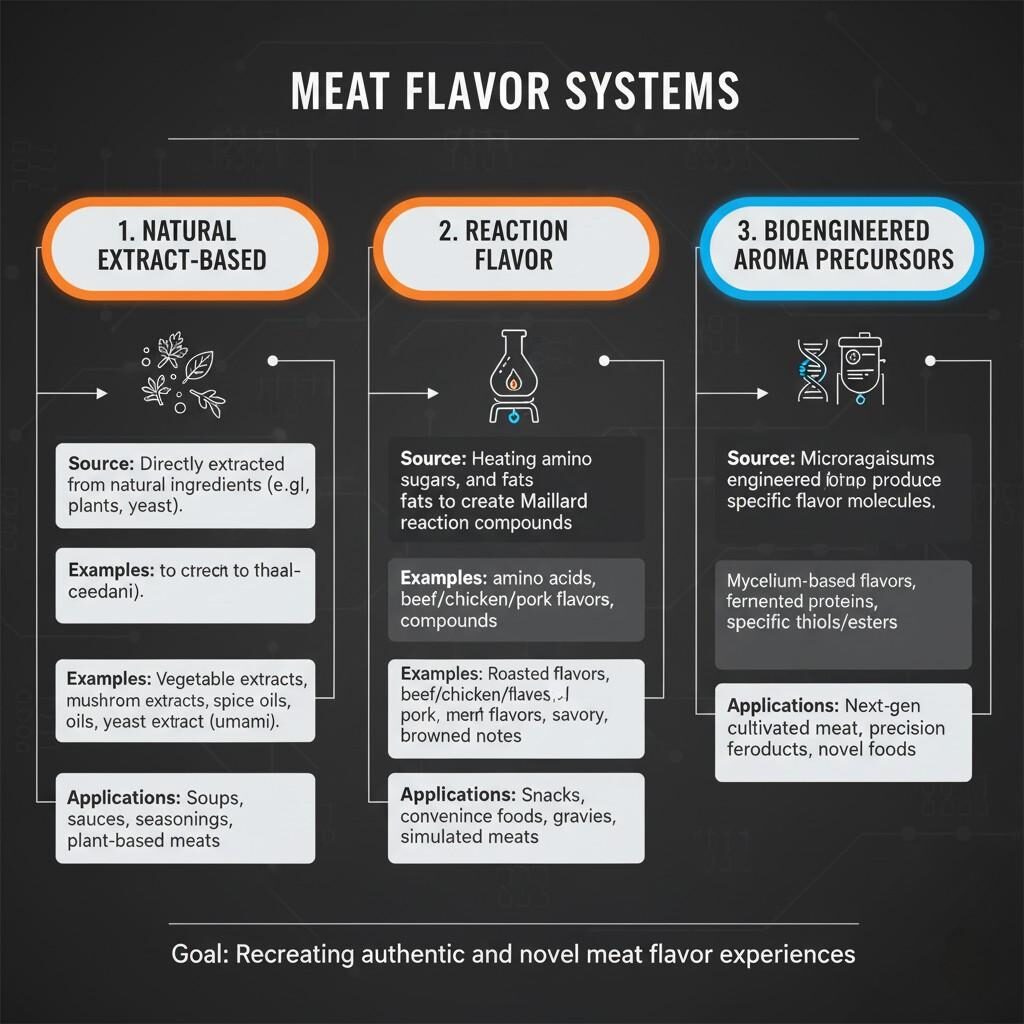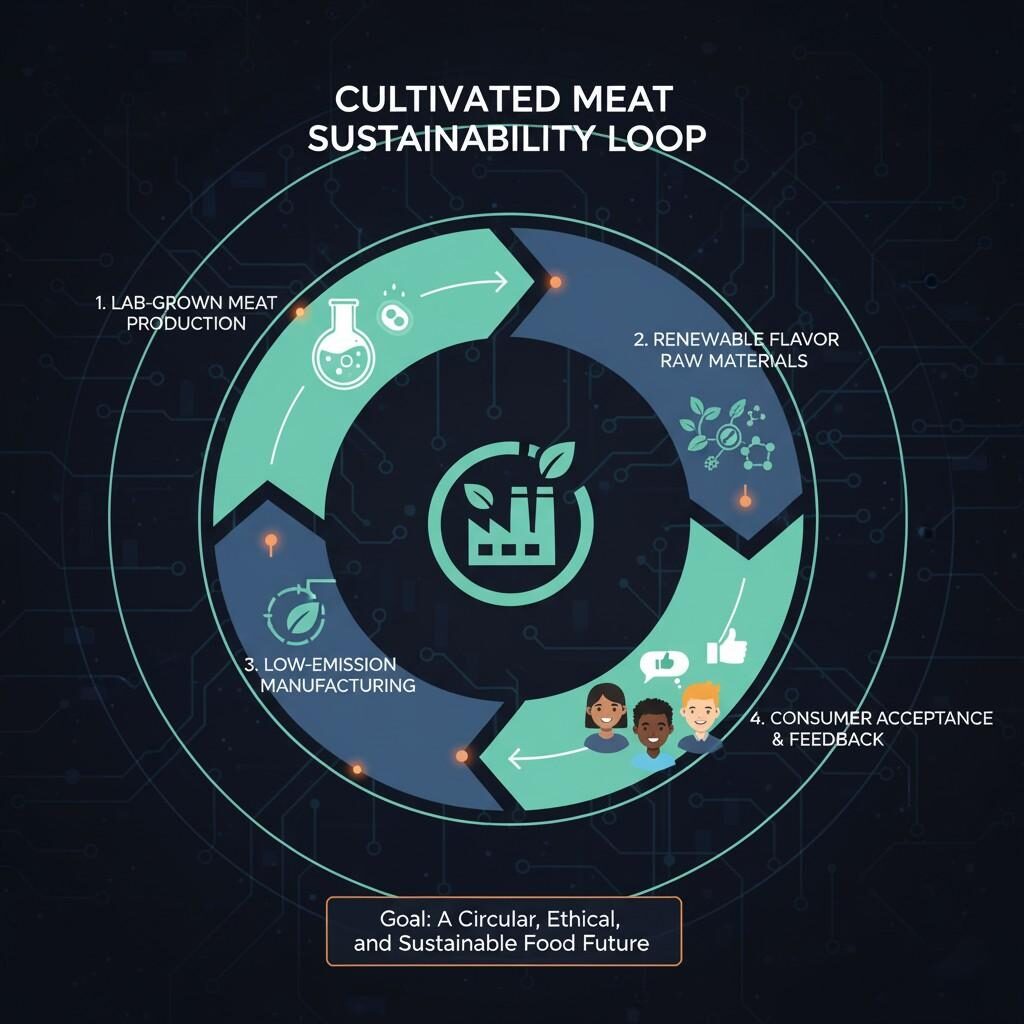发表者:广东独特香精有限公司
上次更新: 十月 22,2025年

人造肉实验室
科学正在重塑食品的未来——这种转变最深刻的莫过于食品的崛起。基于细胞的肉类和人工培育的肉类。这些创新的蛋白质来源是通过细胞培养而不是传统的动物养殖生产的,有望提供更多可持续、道德和高效食物系统。
然而,虽然人工培育的肉类复制了细胞结构和营养对于传统肉类来说,一个关键的感官因素仍然决定着它们的成功:味道.
风味不仅仅是烹饪细节——它是决定的情感和文化桥梁消费者接受度, 品牌差异化, 和市场活力。随着全球食品工业加速实验室培育肉类的商业化,风味科学处于这一新兴类别的核心。
本文探讨了风味开发的技术作用在细胞肉类领域,从分子香气设计到感官优化和工艺集成,为食品创新、配方和风味制造领域的专业人士提供权威指南。
细胞肉或培育肉是由直接培养动物细胞在受控环境中,消除了饲养和屠宰牲畜的需要。该过程通常涉及四个主要阶段:
根据美国食品药品监督管理局(FDA),符合安全和成分标准的养殖肉类产品可以与传统动物产品类似地进行监管[1]。 FDA 和 USDA 的双重监督确保细胞肉可以在食品级生产实践下安全地商业化。
然而,这项突破性技术面临的最大挑战之一是实现传统肉类的真实感官特征,包括其香气、味道和口感。

肉味成分信息图
虽然培育肉的质地现在可以通过 3D 支架和生物打印来密切模仿真实的肌肉组织,风味再现仍然复杂得多.
传统的肉味主要来源于:
美拉德反应烹饪过程中氨基酸和还原糖之间的相互作用。
脂质氧化生成醛、酮、醇等挥发性化合物。
热分解硫化合物,产生咸味或“肉味”。
这些过程取决于肌内脂肪, 血红素蛋白(肌红蛋白), 和氨基酸前体——所有这些都很难在细胞培养环境中自然繁殖。
即使培育肉在营养上与动物肉相同,如果缺乏营养成分,消费者也会拒绝它。香气强度, 多汁性, 和回味他们与传统烹饪联系在一起。
2023 年报告优质食品研究所 (GFI)发现味道感知是#1 感官因素影响全球市场消费者对人造肉的接受度[²]。
因此,开发正宗、稳定且适合烹饪的风味系统对于这些新兴蛋白质来源的商业成功至关重要。
培育肉类风味的开发需要跨学科的专业知识——桥梁食品化学, 细胞生物学, 和感官科学.
调味师现在与生物技术专家合作,解决曾经纯粹是烹饪方面的挑战:
在Cuiguai调味料,我们关注基于 GC-MS 的香气分析和反应风味设计,能够在基于细胞和基于植物的蛋白质系统中复制复杂的肉香味。
在传统肉类中,风味丰富主要来自脂肪氧化产品——例如醛(己醛、壬醛)、内酯和吡嗪。人工培育的肉类通常含有脂质含量较少或使用植物性脂肪替代品,导致芳香复杂度降低。
解决方案:
血红素蛋白如肌红蛋白决定熟肉的颜色和鲜味。由于氧气控制的生长条件,培养系统可能表达较少的肌红蛋白。
解决方案:
在烹饪过程中,美拉德反应会产生数百种风味分子,包括吡嗪、噻唑和呋喃。养殖肉类可能缺乏足够的还原糖或者氨基酸充分触发这些反应。
解决方案:
因为养殖肉类生产涉及细胞培养基和生物反应器条件,任何添加的风味前体必须保留化学性质稳定、无毒在成长过程中。
需要考虑的关键因素:
风味工程师与生物工艺专家合作,确定何时以及如何引入风味或前体——是否收获后或者预煮— 获得最大的感官冲击。

肉味系统比较
它们依靠植物提取物、酵母水解物或酶处理的蛋白质来模仿熟肉的美味复杂性。
酵母提取物:提供鲜味和核苷酸(IMP、GMP)。
水解植物蛋白(HVP):带来烤肉和豆肉的味道。
香料油树脂:添加前调(例如大蒜、洋葱、黑胡椒)。
这些系统非常适合清洁标签配方,与自然定位对齐。
反应风味是通过受控加热产生的还原糖和氨基酸,复制真实肉类烹饪中的美拉德褐变过程。
优点:
配方设计师经常使用半胱氨酸、苏氨酸、核糖, 和硫供体制作平衡的肉类挥发物,例如2-甲基-3-呋喃硫醇,一份招牌牛肉便条。
新兴的生物技术现在使微生物生物合成与熟肉中形成的风味分子相同的风味分子。例如:
这些方法符合精准发酵已用于培育肉类生产的技术——为下一代食品创新创建集成的“生物风味”模型。
风味的成功不仅仅通过化学来判断——它还通过感官反应来验证。
专业小组评估参数,例如:
之间的比较测试栽培肉类与传统肉类帮助调味师调整配置文件以实现均等。
跨市场研究显示偏好风味的区域差异:
了解这些文化的细微差别使香料制造商能够本地化全球培育肉的推出有效地。
风味融合的时机和方式极大地影响最终的感官体验。
封装材料可包括改性淀粉、麦芽糖糊精或脂质微胶囊,确保受控释放和氧化保护。

人造肉可持续发展循环
人造肉已经解决了动物福利和减少碳足迹,但风味系统也必须符合相同的道德和环境目标。
使用可再生的、植物来源的芳香分子减少了对石化合成的依赖,同时支持清洁标签声明。
反应香料可以在以下条件下生产低温酶催化,最大限度地减少碳排放并保留精致的香气。
现代消费者希望了解成分来源和制造过程。合作伙伴经过认证的香精制造商确保符合欧盟、FDA 和中国 GB 标准,同时保持信任。
风味研发团队旨在为栽培产品复制新鲜烤鸡胸肉的风味。
最终提供的风味系统真实、稳定、标签友好结果与培育肉的质地和加工相一致——证明了精密风味工程在该领域的可行性。
随着人造肉从试点实验室转移到商业货架上,风味将决定竞争的成功.
未来的方向包括:
根据粮食及农业组织(FAO),全球替代蛋白产量可能达到到 2035 年占肉类总供应量的 10%,风味技术是消费者接受的关键推动因素[³]。
生物技术、感官分析和风味化学的融合将改变世界感知和享受可持续蛋白质的方式。
细胞培育肉类标志着食品创新的历史性转折点——将可持续性与卓越感官结合起来。然而,如果没有正宗、精心设计的口味,即使是最先进的蛋白质也有达不到消费者期望的风险。
在Cuiguai调味料,我们结合GC-MS 香气分析, 美拉德反应工程, 和生物发酵风味技术为您量身定制解决方案新兴蛋白质来源。我们的专业知识使食品创新者不仅能够提供合乎道德的营养,而且难忘的味觉体验定义了美食的下一个时代。
请联系我们的专家技术合作, 风味配方支持, 或者样品请求为您的下一代食品项目量身定制。
📩索取免费样品或技术交流
📩[信息@cuiguai.com]
📞[+86 189 2926 7983]
🌐探索更多【www.cuiguai.cn】
[1]美国食品和药物管理局(FDA)。人造肉监管框架,2023。
[²] 优质食品研究所(GFI)。消费者对人造肉认知的见解,2023。
[3] 粮食及农业组织(FAO)。可持续蛋白质系统的未来,2024 年。
[⁴]食品技术研究所(IFT)。替代蛋白质中的风味化学, 食品科学杂志,卷。 89, 2024。
Copyright © 2025 广东独特香精香料有限公司 版权所有版权所有。